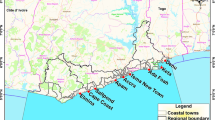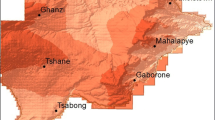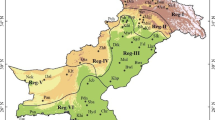Abstract
Diurnal temperature range (DTR) is an important index in climate change studies in addition to its influence upon environment and thermal comfort. Understanding variability in DTR at regional scales is, thus, important. In Fiji and other Pacific Island countries, DTR information is important in forecasting thermal comfort. This work is based on Fiji using gauge-based gridded mean monthly DTR data from the Climatic Research Unit (CRU). Annual and monthly DTR for the second half of the twentieth century to the present day are analyzed to establish temporal trends and spatial patterns. A combination of parametric and non-parametric tests was applied to investigate trend, correlation, simple linear regression, and interannual variability in the datasets. Findings show that DTR increases with an increase in latitude over Fiji. The mean monthly DTR between 6.58 and 7.37 °C in June and January coincide with winter and summer, respectively. Cumulative annual mean (CAM) of T, Tmx, and DTR showed increasing trends during the study period while the CAM of Tmn depicted a decreasing trend. Results suggest that DTR has a positive significant (insignificant) correlation with Tmx (T), but shows an opposing significant relationship with Tmn at 5% significance level. Each of DTR, Tmx, Tmn, and T experienced a general increase in values across the timeframe provided by the data. Records show an overall increase of 0.05 °C/decade in DTR. However, since the early 1990s, DTR has been characterized by a downward trend. Nonetheless, the overall trend of increasing DTR is explained by a greater increase in maximum temperatures over minimum temperatures. The observed rate of increase in DTR in warm months exceeds that in cold months. The findings form a baseline for further studies investigating the factors influencing DTR variability, and how the variability is affecting human thermal comfort.
Similar content being viewed by others
References
Albert S, Bronen R, Tooler N, Leon J, Yee D, Ash J, Boseto D, Grinham A (2018) Heading for the hills: climate-driven community relocations in the Solomon Islands and Alaska provide insight for a 1.5 °C future. Reg Environ Change 18:2261–2272. https://doi.org/10.1007/s10113-017-1256-8
Bilbao J, Román R, De Miguel A (2019) Temporal and spatial variability in surface air temperature and diurnal temperature range in Spain over the period 1950–2011. Climate 7:16. https://doi.org/10.3390/cli7010016
Braganza K, Karoly DJ, Arblaster JM (2004) Diurnal temperature range as an index of global climate change during the twentieth century. Geosphys Res Lett 31:L13217. https://doi.org/10.1029/2004GL019998
Chattopadhyay M, Katzfey J (2015) Simulating the climate of South Pacifc islands using a high resolution model. Int J Climatol 35:1157–1171. https://doi.org/10.1002/joc.4046
Dai A, Trenberth KE, Karl TR (1999) Effects of clouds, soil moisture, precipitation, and water vapor on diurnal temperature range. J Climate 12:2451–2473. https://doi.org/10.1175/1520-0442(1999)012%3c2451:EOCSMP%3e2.0.CO;2
Easterling DR, Horton B, Jones PD, Peterson TC, Karl TR, Parker DE, Salinger MJ, Razuvayev V, Plummer N, Jamason P, Folland CK (1997) Maximum and minimum temperature trends for the globe. Science 777:364–367. https://doi.org/10.1126/science.277.5324.364
FMS (2006) The climate of Fiji. Information Sheet No. 35, Fiji Meteorological Service: Nadi, Fiji. https://www.met.gov.fj/index.php?page=fijiclimate. Accessed 22 Oct 2019
Folland CK, Salinger MJ, Jiang N, Rayner NA (2003) Trends and variations in South Pacific Island and ocean surface temperatures. J Climate 16:2859–2874. https://doi.org/10.1175/1520-0442(2003)016%3c2859:TAVISP%3e2.0.CO;2
Ghani SS, Iqubal MA, Prasad R, Deo A (2017) Trends in mean maximum temperature, mean minimum temperature and mean relative humidity for Lautoka, Fiji during 2003–2013. Sci Rev Eng Env Sci 26:415–422. https://doi.org/10.22630/PNIKS.2017.26.4.40
Giorgi F, Lionello P (2008) Climate change projections for the Mediterranean region. Glob Planet Change 63:90–104. https://doi.org/10.1016/j.gloplacha.2007.09.005
Glantz MH (2001) Currents of change: Impacts of El Niño and La Niña on climate and society, 2nd edn. Cambridge University Press, Cambridge
Hamed KH, Rao AR (1998) A modified Mann–Kendall trend test for autocorrelated data. J Hydrol 204:182–196. https://doi.org/10.1016/S0022-1694(97)00125-X
Harris I, Jones PD, Osborn TJ, Lister DH (2014) Updated high-resolution grids of monthly climatic observations—the CRU TS3.10 Dataset. Int J Climatol 34:623–642. https://doi.org/10.1002/joc.3711
Hasanean HM, Basset AH (2006) Variability of summer temperature over Egypt. Int J Climatol 26:1619–1634. https://doi.org/10.1002/joc.1321
Hastings DA, Dunbar PK (1999) Global land 1-km base elevation (GLOBE) digital elevation model, documentation, vol 1.0. Key to geophysical records documentation (KGRD) 34. National Oceanic and Atmospheric Administration, National Geophysical Data Center, 325 Broadway, Boulder, Colorado 80303, USA. https://iridl.ldeo.columbia.edu/SOURCES/.NOAA/.NGDC/.GLOBE/.topo/index.html?Set-Language=en. Accessed 10 Feb 2020
IPCC (2013) Climate change 2013: the physical science basis. In: Stocker TF, Qin D, Plattner G-K, Tignor M, Allen SK, Boschung J, Nauels A, Xia Y, Bex V, Midgley PM (eds) Contribution of working group I to the fifth assessment report of the Intergovernmental Panel on Climate Change. Cambridge University Press, Cambridge. https://doi.org/10.1017/CBO9781107415324
IPCC (2018) Summary for policymakers. In: Masson-Delmotte V, Zhai P, Pörtner H-O, Roberts D, Skea J, Shukla PR, Pirani A, Moufouma-Okia W, Péan C, Pidcock R, Connors S, Matthews JBR, Chen Y, Zhou X, Gomis MI, Lonnoy E, Maycock T, Tignor M, Waterfield T (eds) Global Warming of 1.5 °C. An IPCC Special Report on the impacts of global warming of 1.5 °C above pre-industrial levels and related global greenhouse gas emission pathways, in the context of strengthening the global response to the threat of climate change, sustainable development, and efforts to eradicate poverty. https://www.ipcc.ch/site/assets/uploads/sites/2/2019/05/SR15_SPM_version_report_LR.pdf. Accessed 1 Nov 2019 (in press)
Irving DB, Perkins SE, Brown JR, Gupta SA, Moise AF, Murphy BF, Muir LC, Colman RA, Power SB, Delage FP, Brown JN (2011) Evaluating global climate models for the Pacific island region. Clim Res 49:169–187. https://doi.org/10.3354/cr01028
Jones PD, Hulme M (1996) Calculating regional climatic time series for temperature and precipitation: methods and illustrations. Int J Climatol 16:361–377. https://doi.org/10.1002/(SICI)1097-0088(199604)16:4%3C361:AID-JOC53%3E3.0.CO;2-F
Karl TR, Kukla G, Razuvayev VN, Changery MJ, Quayle RG, Heim RR Jr, Easterling DR, Fu CB (1991) Global warming: evidence for asymmetric diurnal temperature change. Geophys Res Lett 18:2253–2256. https://doi.org/10.1029/91GL02900
Karl T, Knight R, Gallo K, Peterson T, Jones P, Kukla G, Plummer N, Razuvayev V, Lindseay J, Charson R (1993) A new perspective on recent global warming: asymmetric trends of daily maximum and minimum temperature. Bull Am Meteorol Soc 74:1007–1023. https://doi.org/10.1175/1520-0477(1993)074%3c1007:ANPORG%3e2.0.CO;2
Katz RW, Glantz MH (1986) Anatomy of a rainfall index. Mon Weather Rev 114:764–771. https://doi.org/10.1175/1520-0493(1986)114%3c0764:AOARI%3e2.0.CO;2
Kendall MG (1938) A New Measure of Rank Correlation. Biometrika 30:81–93. https://doi.org/10.2307/2332226
Kumar VV, Deo RC, Ramachandran V (2006) Total rain accumulation and rain-rate analysis for small tropical Pacific islands: a case study of Suva, Fiji. Atmos Sci Let 7:53–58. https://doi.org/10.1002/asl.131
Kumar R, Stephens M, Weir T (2013) Temperature trends in Fiji: a clear signal of climate change. S Pacif J Nat Appl Sci 31:27–38. https://doi.org/10.1071/SP13002
Libanda B, Nkolola NB, Chilekana N, Bwalya K (2019) Dominant east–west pattern of diurnal temperature range observed across Zambia. Dyn Atmos Oceans 86:153–162. https://doi.org/10.1016/j.dynatmoce.2019.05.001
Liu B, Xu M, Henderson M, Qi Y, Li Y (2004) Taking China’s temperature: daily range, warming trends, and regional variations, 1955–2000. J Clim 17:4453–4462. https://doi.org/10.1175/3230.1
Lozowski EP, Charlton RB, Nguyen CD, Wilson JD (1989) The use of cumulative monthly mean temperature anomalies in the analysis of local interannual climate variability. J Clim 2:1059–1068. https://doi.org/10.1175/1520-0442(1989)002%3c1059:TUOCMM%3e2.0.CO;2
Mann BH (1945) Nonparametric tests against trend. Econometrica 13:245–259
Mataki M, Koshy KC, Lal M (2006) Baseline climatology of Viti Levu (Fiji) and current climatic trends. Pac Sci 60:49–68
Ongoma V, Chen H, Gao C, Sagero PO (2018) Variability of temperature properties over Kenya based on observed and reanalyzed datasets. Theor Appl Climatol 133:1175–1190. https://doi.org/10.1007/s00704-017-2246-y
Paaijmans KP, Blanford S, Bell AS, Blanford JI, Read AF, Thomas MB (2010) Influence of climate on malaria transmission depends on daily temperature variation. Proc Natl Acad Sci USA 107:15135–15139. https://doi.org/10.1073/pnas.1006422107
Pavia EG, Graef F (2002) The recent rainfall climatology of the Mediterranean Californias. J Clim 15:2697–2701. https://doi.org/10.1175/1520-0442(2002)015%3c2697:TRRCOT%3e2.0.CO;2
Punia M, Nain S, Kumar A, Singh BP, Prakash A, Kumar K, Jain VK (2015) Analysis of temperature variability over north-west part of India for the period 1970–2000. Nat Hazards 75:935–952. https://doi.org/10.1007/s11069-014-1352-8
Qu M, Wan J, Hao X (2014) Analysis of diurnal air temperature range change in the continental United States. Weather Clim Extremes 4:86–95. https://doi.org/10.1016/j.wace.2014.05.002
Ritchie H, Roser M (2019) CO2 and greenhouse gas emissions. OurWorldInData.org. https://ourworldindata.org/co2-and-other-greenhouse-gas-emissions. Accessed 5 Nov 2019
Salinger MJ (1995) Southwest Pacific temperatures: trends in maximum and minimum temperatures. Atmos Res 37:87–99. https://doi.org/10.1016/0169-8095(94)00071-K
Sen PK (1968) Estimates of the regression coefficient based on Kendall’s tau. J Amer Stat Assoc 63:1379–1389. https://doi.org/10.2307/2285891
Sneyers R (1990) On the statistical analysis of series of observations. WMO Technical Note 143, WMO No. 415, TP-103, World Meteorological Organization, Geneva, Switzerland
Sun X, Ren G, You Q, Ren Y, Xu W, Xue X, Zhan Y, Zhang S, Zhang P (2019) Global diurnal temperature range (DTR) changes since 1901. Clim Dyn 52:3343–3356. https://doi.org/10.1007/s00382-018-4329-6
Thorne PW, Menne MJ, Williams CN, Rennie JJ, Lawrimore JH, Vose RS, Peterson TC, Durre I, Davy R, Esau I, Klein-Tank AMG, Merlone A (2016) Reassessing changes in diurnal temperature range: a new data set and characterization of data biases. J Geosphys Res Atmos 121:5115–5137. https://doi.org/10.1002/2015JD024584
Vinnarasi R, Dhanya CT, Chakravorty A, AghaKouchak A (2017) Unravelling diurnal asymmetry of surface temperature in different climate zones. Sci Rep 7:7350. https://doi.org/10.1038/s41598-017-07627-5
Wang Y, Shilenje WZ (2017) Variability of diurnal temperature range in East Africa during 1921–2010. J Trop Meteorol 23:345–356. https://doi.org/10.16555/j.1006-8775.2017.04.001
Wang F, Zhang C, Peng Y, Zhou H (2014) Diurnal temperature range variation and its causes in a semiarid region from 1957 to 2006. Int J Climatol 34:343–354. https://doi.org/10.1002/joc.3690
Xia X (2013) Variability and trend of diurnal temperature range in China andtheir relationship to total cloud cover and sunshine duration. Ann Geophys 31:795–804. https://doi.org/10.5194/angeo-31-795-2013
Zebiak SE, Orlove B, Munoz AG, Vaughan C, Hansen J, Troy T, Thomson MC, Lustig A, Garvin S (2015) Investigating El Nin˜o-Southern Oscillation and society relationships. WIREs Clim Change 6:17–34. https://doi.org/10.1002/wcc.294
Acknowledgements
The authors are thankful to The University of East Anglia (UEA) Climatic Research Unit (CRU) for providing the data used in this study. A lot of appreciation goes to The University of the South Pacific for providing a research-enabling environment.
Author information
Authors and Affiliations
Corresponding author
Additional information
Responsible Editor: S. Fiedler.
Publisher's Note
Springer Nature remains neutral with regard to jurisdictional claims in published maps and institutional affiliations.
Rights and permissions
About this article
Cite this article
Ongoma, V., Rahman, M.A., Ayugi, B. et al. Variability of diurnal temperature range over Pacific Island countries, a case study of Fiji. Meteorol Atmos Phys 133, 85–95 (2021). https://doi.org/10.1007/s00703-020-00743-4
Received:
Accepted:
Published:
Issue Date:
DOI: https://doi.org/10.1007/s00703-020-00743-4













